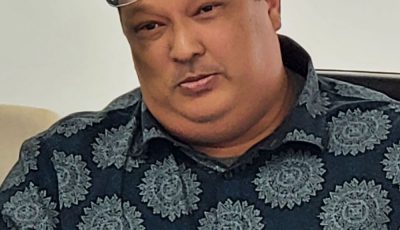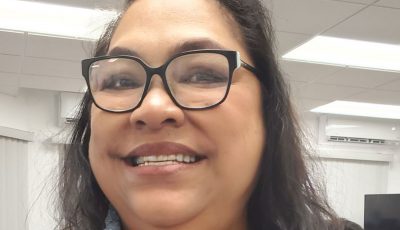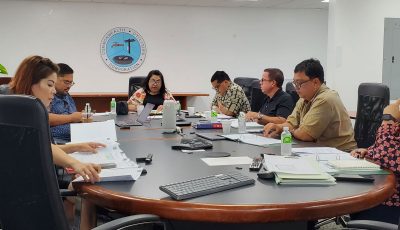BSI siting application certified complete
Off-site drainage, road improvements planned
Regulatory officials on Friday certified as complete Best Sunshine International, Ltd.’s major siting application for a 14-story casino resort in the heart of Garapan, upon the receipt of further supplemental information tomorrow, Tuesday.
The project, called the “Grand Mariana Casino and Hotel Resort,” covers some 447,915 square feet of coastal property inclusive of a mixture of private and public lands. The site, which has been cleared of all vegetation, includes the former Samoan Housing area and borders the Saipan Lagoon.
Best Sunshine’s chief operating officer Matthew Harkness, consultant John Gourley, Bill Hofschneider of Hofschneider Engineering, LLC, counsel Viola Alepuyo, and other individuals working on the environmental and archaeological aspects of the proposed development presented their application to the Division of Coastal and Resources Management board on Friday at the Bureau of Environmental and Coastal Quality conference room in Gualo Rai.
While BSI intends to hook up to the Commonwealth Utilities Corp. for their 9-megawatt power demand, it was disclosed Friday that current public sewer infrastructure is inadequate for their estimated wastewater discharge—some 24,000 gallons of discharge per day.
Hofschneider, accompanied by former BECQ employees David Rosario and Emmanuel Borja, told officials that the projected discharge “would require improvements to CUC’s collection and transmissions system.”
He said they have met with CUC and will continue to meet with CUC over this.
It was later learned that if piping were not improved, wastewater backflow could occur. CUC officials have noted their concern about this potential effect on existing businesses and residents in the area.
“When we develop or make improvements, the government always looks at opportunities to enhance that improvement a little further in terms of accommodating future growth or present load in addition to the development,” Hofschneider said.
He disclosed that “discussions are taking place to incorporate waste flows from” different sewage lift stations in the area. This is a design, logistical as well as a financial issue that needs to be further discussed, he said.
“We are looking at a substantial amount of equipment to accommodate existing flows,” he said. “Government infrastructure is inadequate to support the facility.”
They would need to construct approximately a 10,000-meter pipe pressure system that would tie from flows from lift station to the others in the Garapan area, he said.
His clients have “not flinched and understand their responsibilities,” he assured, but also added that, “we would like to sit with CUC and the community to understand that at a certain point the developer holds up to improvements, but anything beyond that we’ll need to identify the financial parties responsible for that extra improvement for future potential growth.”
In terms of power, BSI has an anticipated demand of 9 megawatts. The hotel casino will have backup generation in case of intermittent interruptions. “We are ready to partner with CUC,” Hofschneider said.
Economic benefits
According to chief operating officer, Matt Harkness, BSI projects some 420 employees needed for the hotel casino.
In a pitch to officials, Harkness referred to his experiences working for Native American-owned Four Winds Casino Resort in New Buffalo, Michigan. He also has worked in Atlantic City’s gambling industry.
Harkness said economic benefits were generated from casino fees, but noted that the “real benefits” came for the underemployed, unemployed, or people not in the area.
He noted these benefits were “not just jobs, they are careers” and a “catalyst for locals,” adding that a majority of executives were “native.”
Like in Native American tribes, there may be an “emigration” on island as well, he noted.
Department of Commerce director David Palacios commended BSI’s goal of hiring 65 percent of local available, noting that Labor only requires 30 percent. “That should help employ” people, he said.
Off-property projects
Significant off-site projects, hinging on government support and cost-effectiveness, were also discussed.
Noting a polluted and foul drainage canal beside the hotel lot, Hofschneider said the developer is keen on this canal being redesigned.
“We need to identify the other [pollutant] sources entering the canal,” he said, noting that the structural repairs aspect would be a “breeze.”
The “salient point,” though, with the developer is the unsightly storm water that flows out into the lagoon beside their proposed hotel, he said.
“Improvements are more than due,” he said. “They need to take place. What degree of treatment, what degree of water quality we are trying to achieve…is going to be a subject of discussion.”
They are looking for cost-effective way to improve the canal, he said, urging the officials to take on the task with them.
“These are costs that is being borne by the developer. These off-site improvements like improving the canal structurally and identifying the solutions to improve the water quality…are not easy.”
“We are going to enlist the team of government agencies. We’re going to be popping manholes and…we can’t do it ourselves. But you guys have certain rights [and] authority. We’re going to put you to task to help us identify these sources and help plug them,” he said.
Other plans
According to Vanessa Cabrera, who was part of the archeological recovery efforts on site, their work is 99 percent complete. The remaining areas to be completed are on the dense mitten areas and several burial complexes. They have uncovered 50 burials, and 40 isolated bones, she said in her presentation to DCRM officials.
CUC manager Gary Camacho urged BSI to be a leader in among other developments in the area, calling it “critical to connect with the community.”
The issue with wastewater might be complicated, he said, as CUC doesn’t have the resources at this particular junction to address this.
Camacho also said the area a “key, key area” when it came to local people and their history. “It’s going to become more passionate,” he said, referring to ancient burials dug on site.
For the hotel casino, BSI’s solid waste would amount to an estimated 619 lbs daily on site. There were no estimates yet for the construction phase.
For portable water, BSI is planning a self-contained water system, inclusive of reverse osmosis, and underground well systems, among others. The casino resort would require an estimated 254 gallons per day of potable water. This would be supplied by three on-site high salinity deep wells. The water would be processed and the waste stream disposed of through two underground injection control wells, or two UIC wells.
For the area around their property, BSI will be resurfacing Orchid Street and making improvements to the intersection between Beach Road and Orchid St.
Hibiscus Street, which runs between Best Sunshine property and the ABC store and the Hafadai Beach Hotel, will also be paved. This road would be a two-lane road with a sidewalk. It would be reduced from 45 feet to 30 feet but with improvements.
BSI is at work with Marianas Visitors Authority on a traffic study around the site.
BSI is also asking for exemptions to local “shoreline setback” laws, or the distance by which a certain buildings can be near the shore.
DCRM director Fran Castro said they aim for a public hearing for the end of June, around June 25 or 26.



























